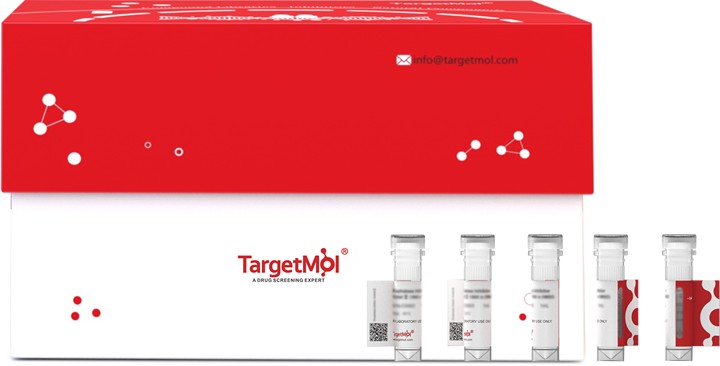- Remove All
 Your shopping cart is currently empty
Your shopping cart is currently empty
Shopping Cart
CD300A Protein, Cynomolgus, Recombinant (Avi), Biotinylated
Catalog No. TMPK-00560
CD300a is an inhibitory receptor for mast cells and eosinophils in allergic inflammation (AI); however, the spatiotemporal expression of CD300a and its potential roles in the resolution of AI are still to be determined.CD300a expression on peritoneal cells is regulated from inflammation to resolution. CD300a activation on mouse bone marrow-derived mast cells regulated ALX/FPR2 expression levels following IgE-mediated activation. CD300A Protein, Cynomolgus, Recombinant (Avi), Biotinylated is expressed in HEK293 mammalian cells with C-Avi tag. The predicted molecular weight is 19.44 kDa and the accession number is A0A7N9CE79.

CD300A Protein, Cynomolgus, Recombinant (Avi), Biotinylated
Catalog No. TMPK-00560
CD300a is an inhibitory receptor for mast cells and eosinophils in allergic inflammation (AI); however, the spatiotemporal expression of CD300a and its potential roles in the resolution of AI are still to be determined.CD300a expression on peritoneal cells is regulated from inflammation to resolution. CD300a activation on mouse bone marrow-derived mast cells regulated ALX/FPR2 expression levels following IgE-mediated activation. CD300A Protein, Cynomolgus, Recombinant (Avi), Biotinylated is expressed in HEK293 mammalian cells with C-Avi tag. The predicted molecular weight is 19.44 kDa and the accession number is A0A7N9CE79.
| Pack Size | Price | Availability | Quantity |
|---|---|---|---|
| 100 μg | $932 | 7-10 days | |
| 500 μg | $3,720 | 7-10 days | |
| 1 mg | $6,210 | 7-10 days |
Bulk & Custom
Add to Cart
Resource Download
Product Information
| Biological Activity | Activity has not been tested. It is theoretically active, but we cannot guarantee it. If you require protein activity, we recommend choosing the eukaryotic expression version first. |
| Description | CD300a is an inhibitory receptor for mast cells and eosinophils in allergic inflammation (AI); however, the spatiotemporal expression of CD300a and its potential roles in the resolution of AI are still to be determined.CD300a expression on peritoneal cells is regulated from inflammation to resolution. CD300a activation on mouse bone marrow-derived mast cells regulated ALX/FPR2 expression levels following IgE-mediated activation. CD300A Protein, Cynomolgus, Recombinant (Avi), Biotinylated is expressed in HEK293 mammalian cells with C-Avi tag. The predicted molecular weight is 19.44 kDa and the accession number is A0A7N9CE79. |
| Species | Cynomolgus |
| Expression System | HEK293 Cells |
| Tag | C-Avi |
| Accession Number | A0A7N9CE79 |
| Synonyms | Pigr4,NKRL,Mcipr1,MAIR-I,LMIR1,IRp60,IRC1,IGSF12,CLM-8,CLM8,CD300a |
| Construction | Leu18-Gln178 |
| Protein Purity | > 95% as determined by Tris-Bis PAGE; > 95% as determined by HPLC |
| Molecular Weight | 19.44 kDa (predicted). Due to glycosylation, the protein migrates to 50-70 kDa based on Tris-Bis PAGE result. |
| Endotoxin | < 1 EU/μg by the LAL method. |
| Formulation | Lyophilized from a solution filtered through a 0.22 μm filter, containing PBS (pH 7.4). Typically, 8% trehalose is incorporated as a protective agent before lyophilization. |
| Reconstitution | Reconstitute the lyophilized protein in distilled water. The product concentration should not be less than 100 μg/ml. Before opening, centrifuge the tube to collect powder at the bottom. After adding the reconstitution buffer, avoid vortexing or pipetting for mixing. |
| Stability & Storage | It is recommended to store recombinant proteins at -20°C to -80°C for future use. Lyophilized powders can be stably stored for over 12 months, while liquid products can be stored for 6-12 months at -80°C. For reconstituted protein solutions, the solution can be stored at -20°C to -80°C for at least 3 months. Please avoid multiple freeze-thaw cycles and store products in aliquots. |
| Shipping | In general, Lyophilized powders are shipping with blue ice. |
| Research Background | CD300a is an inhibitory receptor for mast cells and eosinophils in allergic inflammation (AI); however, the spatiotemporal expression of CD300a and its potential roles in the resolution of AI are still to be determined.CD300a expression on peritoneal cells is regulated from inflammation to resolution. CD300a activation on mouse bone marrow-derived mast cells regulated ALX/FPR2 expression levels following IgE-mediated activation. |
Dose Conversion
You can also refer to dose conversion for different animals. More
Calculator
Tech Support
Please read the User Guide of Recombinant Proteins for more specific information.

Copyright © 2015-2025 TargetMol Chemicals Inc. All Rights Reserved.


